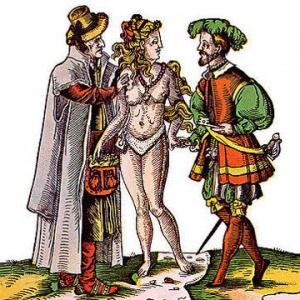By Marri Lynn (W&M Contributor)
 If pad commercials were made in the middle ages, there would be no women in linen dresses running in slow motion across beaches.
If pad commercials were made in the middle ages, there would be no women in linen dresses running in slow motion across beaches.
The next closest thing to these commercials — medieval pseudomedical treatises — presented a very different idea of what women should expect during their time of the month. These books, like the Trotula and others, certainly reveal the expectations of men, who more frequently wrote, possessed, and read these works.
Because of a woman’s humoural qualities, being both wetter and colder than men, she suffered from being unable to fully digest her food. Thus, Nature in her genius, devised menstruation in order that women should be able to excrete the remaining impure, potentially putrefacient matter.
But once this ‘undigested food’ left the female body and emerged into the world, it could be bloody dangerous. By texts alone, menstruation appears to have been a time of danger not only to the woman herself, but the social and natural world around her.
The French version of a text called the Secreta mulierum (“Secrets of Women,” probably composed in the 13th century by Dominican theological Albertus Magnus), paints a particularly gruesome portrait of menstrual blood’s noxious potential. It could generate within itself “vile, horrible, poisonous creatures,” and drive dogs rabid, discolor mirrors, and destroy trees. It could poison a woman from within, whether by menstrual retention – a disease with potentially fatal effects – or by bestowing upon her the ability to inflict harm on children by a mere glance, like a kind of puerperal Medusa.
Yet menstrual blood was not simply poison; it was also necessary for conception. It was called the “flower” of a woman, because in order to be able to bear fruit, women must first flower, like trees. (A poetic metaphor only made possible by the grace that her blood had not been employed to destroy said trees, one imagines.)
Menstrual blood was ascribed the power to become the food for a new life within the womb once conception had occurred, and, once the baby was born, that menstrual blood would be transformed and purified into mother’s milk. Many materia medica in medieval herbals and compilation texts, like mugwort and agnus castus in the De proprietatibus rerum of Bartholomaeus Anglicus, seem to have been included specifically because of their potency in producing or regulating menses. If menstruation could destroy, but also nourish, it paid to be able to reign in such a force.
Whether menstrual blood itself or the menstruation process more broadly was presented as a generative or a corruptive force depended much on social, geographical, and temporal context, and medieval and feminist historians are still teasing out these links and relationships. What already seems clear, though, is that even if a woman (or those around her) may not be able to have the white-linen “happy period,” medical and philosophical literature at least suggested she would have a metaphysically and physiologically significant one.
Marri Lynn holds an MA in the History of Medicine at McGill University, Montreal (2011). She currently studies French, and writes (and copy edits) for the McGill Tribune as well as freelance projects. You can find out more at her About.me page.
